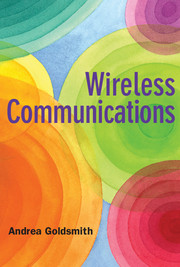Book contents
- Frontmatter
- Contents
- Preface
- List of Abbreviations
- List of Notation
- 1 Overview of Wireless Communications
- 2 Path Loss and Shadowing
- 3 Statistical Multipath Channel Models
- 4 Capacity of Wireless Channels
- 5 Digital Modulation and Detection
- 6 Performance of Digital Modulation over Wireless Channels
- 7 Diversity
- 8 Coding for Wireless Channels
- 9 Adaptive Modulation and Coding
- 10 Multiple Antennas and Space-Time Communications
- 11 Equalization
- 12 Multicarrier Modulation
- 13 Spread Spectrum
- 14 Multiuser Systems
- 15 Cellular Systems and Infrastructure-Based Wireless Networks
- 16 Ad Hoc Wireless Networks
- Appendix A Representation of Bandpass Signals and Channels
- Appendix B Probability Theory, Random Variables, and Random Processes
- Appendix C Matrix Definitions, Operations, and Properties
- Appendix D Summary of Wireless Standards
- Bibliography
- Index
6 - Performance of Digital Modulation over Wireless Channels
Published online by Cambridge University Press: 05 June 2012
- Frontmatter
- Contents
- Preface
- List of Abbreviations
- List of Notation
- 1 Overview of Wireless Communications
- 2 Path Loss and Shadowing
- 3 Statistical Multipath Channel Models
- 4 Capacity of Wireless Channels
- 5 Digital Modulation and Detection
- 6 Performance of Digital Modulation over Wireless Channels
- 7 Diversity
- 8 Coding for Wireless Channels
- 9 Adaptive Modulation and Coding
- 10 Multiple Antennas and Space-Time Communications
- 11 Equalization
- 12 Multicarrier Modulation
- 13 Spread Spectrum
- 14 Multiuser Systems
- 15 Cellular Systems and Infrastructure-Based Wireless Networks
- 16 Ad Hoc Wireless Networks
- Appendix A Representation of Bandpass Signals and Channels
- Appendix B Probability Theory, Random Variables, and Random Processes
- Appendix C Matrix Definitions, Operations, and Properties
- Appendix D Summary of Wireless Standards
- Bibliography
- Index
Summary
We now consider the performance of the digital modulation techniques discussed in the previous chapter when used over AWGN channels and channels with flat fading. There are two performance criteria of interest: the probability of error, defined relative to either symbol or bit errors; and the outage probability, defined as the probability that the instantaneous signal-to-noise ratio falls below a given threshold. Flat fading can cause a dramatic increase in either the average bit error probability or the signal outage probability. Wireless channels may also exhibit frequency-selective fading and Doppler shift. Frequency-selective fading gives rise to intersymbol interference (ISI), which causes an irreducible error floor in the received signal. Doppler causes spectral broadening, which leads to adjacent channel interference (small at typical user velocities) and also to an irreducible error floor in signals with differential phase encoding (e.g. DPSK), since the phase reference of the previous symbol partially decorrelates over a symbol time. This chapter describes the impact on digital modulation performance of noise, flat fading, frequency-selective fading, and Doppler.
AWGN Channels
In this section we define the signal-to-noise power ratio (SNR) and its relation to energy per bit (Eb) and energy per symbol (Es). We then examine the error probability on AWGN channels for different modulation techniques as parameterized by these energy metrics. Our analysis uses the signal space concepts of Section 5.1.
- Type
- Chapter
- Information
- Wireless Communications , pp. 172 - 203Publisher: Cambridge University PressPrint publication year: 2005
- 8
- Cited by

